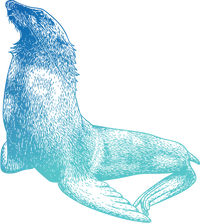The tide is turning along the California coastline, where for the fourth year in a row, sea lions and other marine mammals are stranding on Los Angeles County beaches due to a toxic algal bloom.
The algae produces a neurotoxin called domoic acid and a condition called “domoic acid toxicosis.” When sea lions, seals, dolphins, and sea birds consume fish with domoic acid, it can cause seizures, aggressive behavior, and even death.
“It can present with very unusual neurological symptoms,” Seattle Aquarium’s Senior Veterinary Technician Lindy McMorran explained. “Sometimes you will see sea lions chasing things they normally stay away from.”
But after seeing an unprecedented number of cases, the Marine Mammal Care Center in Los Angeles says the outbreak is now on the decline. “We’re relieved to report that there have been no new patients showing signs of domoic acid (DA) toxicosis this past week and no signs of Pseudo-nitzschia algae detected in Southern California waters as of Friday, May 24,” Chief Operations & Education Officer for the Marine Mammal Care Center Dave Bader said.
Earlier this month, Lindy was contacted by the Marine Mammal Care Center in Los Angeles to help rehabilitate sea lions suffering from the toxic algae and release them once they were healthy. Photos and videos can be found here, courtesy of the Marine Mammal Care Center.
“I was basically there to just be extra hands where they needed it and to help support their team,” Lindy said. “Every day was different. Sometimes I was cleaning, feeding, assisting veterinarians with exams, drawing blood, and helping with releases. During the releases, I would talk to the public on the beach about the rehabilitation work of the Marine Mammal Care Center.”
The Marine Mammal Care Center in Los Angeles, a non-profit organization focused on rescuing and treating sick animals at their hospital, is on the frontlines and is the sole organization authorized by the National Oceanic and Atmospheric Administration (NOAA) to respond to marine mammals in distress throughout the year.
But with the number of calls rising, they can’t do this life-saving work alone. That’s why they call in help from partner institutions like the Seattle Aquarium.
“We typically see about 300 patients per year, and that’s what we budget for,” Dave said. “By April, we had already seen over 400 patients. MMCC’s capacity is stretched when these mass strandings occur, and without the support of our network of partners, we would struggle to care for our patients. Organizations like the Seattle Aquarium stepped up for us in a time of need, and we are so grateful for their help.”
Lindy assisted the team for five days and helped administer treatments, as well as aided in the release of approximately 25 sea lions. But it’s not a quick process.
“The 25 that were released had already been there for more than a month,” Lindy explained. “So, these animals can stay in the hospital anywhere from four weeks to multiple months, depending on their symptoms.”
After several weeks of rehabilitation and receiving a clean bill of health, the team at Marine Mammal Care Center returns to the beach to release the marine mammals.
“Each animal has their own unique exit sometimes,” Lindy said. “It ranges from ‘I’m going to stay in this crate. I’m overwhelmed and stressed,’ to ‘I’m getting out of here,’ and going straight to the water. Some animals even take naps after exiting the crate. It’s all over the place what they do, and what each animal’s reaction will be. It’s just a reminder that they’re all individuals.”
The frequency of these harmful algae blooms (HAB) has risen in recent years, driven by climate change, warming ocean temperatures, and other human activities. During the summer of 2023, the Southern California region experienced its largest HAB event on record, resulting in the deaths of more than 1,000 California sea lions. This season is already outpacing 2023 numbers.
“The frequency of these blooms, along with the number of large-scale marine mammal strandings we’re seeing back to back, is deeply concerning,” Dave said. “We don’t yet know the long-term impacts on marine mammal populations, but the signs are troubling.”
Lindy said she hopes the big outbreak at the beginning of the year is an outlier and that the HAB season will return to its typical number of cases the rest of the year. But with changes to the climate and funding, there are a lot of uncertainties.
However, Lindy left the Marine Mammal Care Center feeling hopeful.
“I think what was impactful was being able to see the optimism, with fewer patients coming in and animals being returned to the wild,” Lindy said. “The first day I was there, there were more than 80 patients, and by the end of my time with the Marine Mammal Care Center, there were about 50. It might not be over, but at least it’s heading in the right direction.”
To learn more about Lindy and her role as a veterinary technician at the Seattle Aquarium, read our web story.
About the Seattle Aquarium:
Founded in 1977, the Seattle Aquarium is a marine conservation organization working to regenerate the health of Earth’s one ocean. We work among global leaders to advance animal wellbeing, marine and ecosystem science, public policy, field conservation, education, and species recovery programs that benefit the ocean. Help support the Aquarium’s mission of Inspiring Conservation of Our Marine Environment.
On the web: SeattleAquarium.org
On Facebook: facebook.com/Aquarium.Seattle
On Instagram: instagram.com/seattleaquarium
On Youtube: youtube.com/seattleaquarium
